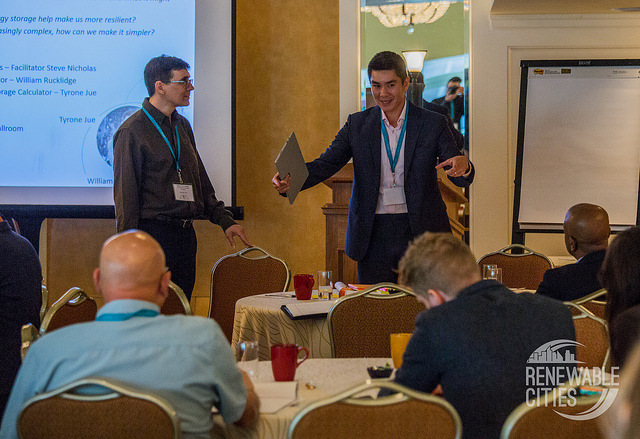Session leaders
- Tyrone Jue, Senior Advisor on the Environment- Office of Mayor Edwin M. Lee, City and County of San Francisco (Presentation)
- Steve Nicholas, Vice President of US Programs, Institute for Sustainable Communities
- William Rucklidge, Software Engineer, Google (Presentation)
Presentations
Steve Nicholas of the Institute for Sustainable Communities’ facilitated this dialogue with input from William Rucklidge, Google’s Project Sunroof, and Tyrone Jue, City of San Francisco Mayor’s Office .
William Rucklidge introduced Project Sunroof, saying it can calculate the solar potential of 60 million rooftops in the USA and can overlay local energy cost data (where available) to determine the potential savings of installing solar photovoltaic (PV) panels. This free online service reduces soft costs because installers do not need to carry out site surveys. Also, it enables cities to evaluate their solar potential at a community scale. The estimates are based on historical analyses of weather and climate data sets and cross-referenced using 3-D modeling (i.e. checked against expected patterns). Rucklidge explained that the program requires high resolution data and information about local costs, which limits the potential for expanding outside of the USA.
Bringing the storage piece into the dialogue, Tyrone Jue presented details about San Francisco’s emergency energy storage calculator. He modeled a scenario in which an earthquake measuring 7.9 on the Richter scale hit San Francisco, which knocked out power for 3-7 days and natural gas distribution for six months. The City of San Francisco developed a tool that sizes a PV and battery system. To calculate the critical load assessment, the tool can upload utility data that show hourly load profiles and can include needs specific to a household or facility in an emergency, including appliances. Jue added that it is important to analyze “disaster-resilient” buildings only since the tool is designed specifically for short-term emergency situations.
Towards resilience planning, San Francisco’s tool is being used to estimate both daytime demand and stored energy for nighttime use by community recovery centres. Existing PV systems are also being updated with battery systems. In considering the cost of the combined system, the economic value of getting the city operating again is incorporated. Other cities are doing similar work, including New York; Duluth, Minnesota; and Rio de Janeiro, Brazil, and a participant noted schools in Latin America are being equipped with solar PV in preparation for emergencies.
Dialogue
Participants were interested in the capacity of the tools to scale between household, institution, and community energy potential and demands. The limits of the calculators are set by the degree of resilience desired and financial capacity of the community. Project Sunroof is collaborating with municipalities to scale up and is developing a strategy to acquire more data and accelerate that work. A challenge is that the data must be consistently updated.
Fostering community connectivity was identified as an important component of resilience that should not be overlooked. Beyond emergency planning, a participant raised the importance of democratizing energy by decentralizing control and rebuilding the grid to ensure everyone has access. San Francisco is aiming for “shared prosperity” and one participant commented, “It’s the current centralized system that creates the haves and have nots.”
Participants also discussed the technical and legal aspects of these data-based tools; who is looking at the data and how are they using it? What uses are acceptable and what are not? For example, can census data be used to identify areas that would benefit from subsidized solar installations?
Key Takeaways
Two different calculators created by two different institutions, one a private corporation, the other a municipality, both demonstrate:
- Solar PV potential can be calculated on a community scale.
- Cost analyses should include the benefits of grid stability and the impact of powering up quickly following an emergency event.
- The shift to distributed solar PV increases resilience and shares the social and economic benefits of energy production.
- Answers to questions around legal and ethical uses of demographic and energy use data are evolving with the technology.
